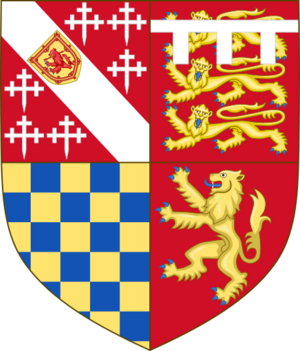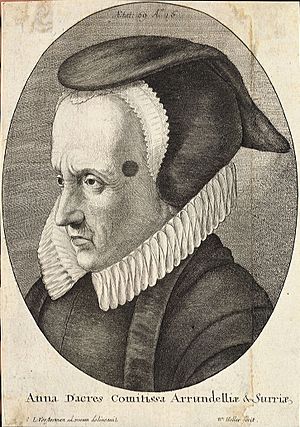Philip Howard, 13th Earl of Arundel facts for kids
Quick facts for kids
The Earl of Arundel
|
|
|---|---|
| Earl of Surrey (of courtesy) 1557 – 1572 Earl of Arundel 1580 – 1589 | |
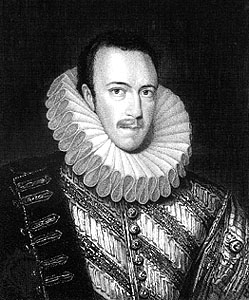
Philip Howard, Earl of Arundel and English Catholic martyr.
|
|
| Born | 28 June 1557 Strand, London, England |
| Died | 19 October 1595 (aged 38) Tower of London, London |
| Buried | Chapel of St Peter ad Vincula, Tower of London 1595 – 1624
Fitzalan Chapel, Arundel Castle 1624 – 1971 Arundel Cathedral 1971 to present. |
| Noble family | Howard |
| Spouse(s) | Anne Dacre |
| Issue | Thomas Howard, 14th Earl of Arundel |
| Parents | Thomas Howard, 4th Duke of Norfolk Lady Mary FitzAlan |
Philip Howard, 13th Earl of Arundel (born June 28, 1557 – died October 19, 1595) was an important English nobleman. He is known for his strong Catholic faith during a time when England was mostly Protestant under Queen Elizabeth I. Because of his beliefs and accusations of plotting against the Queen, he was sent to the Tower of London in 1585. Philip Howard spent ten years there until he died. He was later recognized as a saint by the Catholic Church in 1970. He is one of the Forty Martyrs of England and Wales.
Contents
Who Was Philip Howard?
Philip Howard was born in London in 1557. This was a time of big changes in England, especially with religion. He was the only son of Thomas Howard, 4th Duke of Norfolk and his first wife, Mary FitzAlan. His mother died shortly after he was born.
Philip was named after his godfather, King Philip II of Spain. His other godfather was his grandfather, the 12th Earl of Arundel. His godmother was his great-grandmother, Elizabeth Howard, Duchess of Norfolk.
Growing Up and Family Life
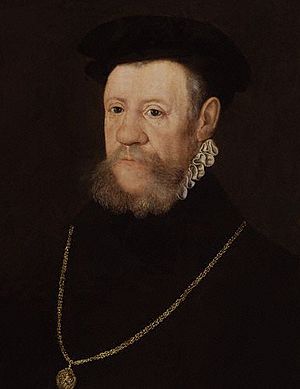
When Philip was seven, his home became a former monastery. As the oldest son, he was expected to become the next Duke of Norfolk. From birth, he held the title of Earl of Surrey.
In 1569, when Philip was 12, his father arranged for him to marry his step-sister, Anne Dacre. They were both very young, so the ceremony was repeated two years later.
Challenges for Philip's Family
Philip's father, the Duke of Norfolk, was a Catholic who had a Protestant education. He was arrested in 1569 for being involved in plans against Queen Elizabeth I. He was accused of wanting to marry Mary, Queen of Scots. Even though he was released, he was arrested again in 1571 for another plot. He was executed in 1572, when Philip was almost 15.
After his father's death, Philip and his younger half-siblings were cared for by their uncle, Henry Howard, Earl of Northampton. They lived at their uncle's home, Audley End. Because his father was executed, Philip lost many family lands and the title of Earl of Surrey. However, he and his siblings later got some of their properties back.
Education and Court Life
Philip went to study at St John's College, Cambridge. While he was there, his wife, Anne, was looked after by his maternal grandfather.
Philip finished his studies in 1574, at age 17. He started attending Queen Elizabeth I's court when he was 18. This was surprising because his own father had been executed for treason against the Queen just a few years earlier. Philip became a favorite of the Queen, even with his family's difficult past.
In 1578, Philip's aunt, Jane FitzAlan, died without children. This meant Philip became the only living descendant of his maternal grandfather. He inherited the title of Earl of Arundel and many properties, including Arundel Castle. After his grandfather died in 1580, Queen Elizabeth made Philip the Earl of Arundel. This title has stayed in the Howard family ever since.
Why Was Philip Imprisoned?
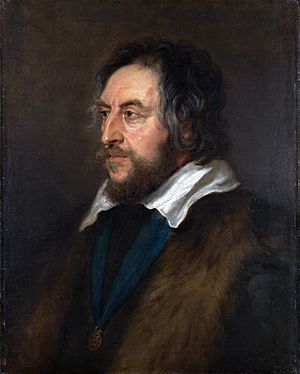
In 1581, Philip was at a discussion in the Tower of London between Protestant thinkers and Catholic priests. This made him think deeply about his own faith. He decided to return to the Catholic Church, even though it was dangerous at the time.
Philip had been baptized Catholic, and even with a Protestant education, his family had strong Catholic roots. His maternal grandfather was Catholic, and his father, though educated as a Protestant, was also Catholic and had been executed for plotting against the Queen.
In 1583, Philip was suspected of being involved in another plot against the Queen. He planned to escape to Europe, but Queen Elizabeth visited his home and ordered him to stay there.
That same year, Philip's wife, Anne, secretly returned to the Catholic Church. She was very afraid of her husband's reaction, but she managed to win back his affection.
Becoming a Catholic and Arrest
On September 30, 1584, Philip secretly became a Catholic again with the help of a Jesuit priest. His younger half-brother also became Catholic. Philip tried to keep his faith a secret while still attending court. He later withdrew to his home to focus on his family.
The next year, Philip tried to flee to Europe to live openly as a Catholic with his family. However, his plan was betrayed by a trusted servant. Philip was a distant cousin of Queen Elizabeth, and some Catholics who wanted to change the government saw him as a possible heir to the throne.
His ship was stopped by the navy as he was leaving Littlehampton. He was arrested on April 25, 1585, and sent to the Tower of London.
Life in the Tower of London
Philip was accused of being a Catholic, leaving England without permission, and being involved in plots. He was fined a large sum of money and sentenced to prison. In 1586, he was offered freedom if he would attend a Protestant church service with the Queen, but he refused.
In 1588, he was accused of praying for the success of the Spanish Armada, a fleet of ships sent by Spain to attack England. He was tried for treason in 1589 and found guilty. He was sentenced to death, and all his titles and property were taken by the Crown.
Queen Elizabeth never signed his death warrant, but Philip was never told this. He lived in fear of execution. He found comfort in a dog, which helped him exchange secret messages with other prisoners, including a priest named Robert Southwell. Philip loved his dog, and there is a statue of him with his dog at Arundel Cathedral.
On a wall in his cell, Philip scratched these words: "The more affliction [we endure] for Christ in this world, the more glory [we shall obtain] with Christ in the next." This phrase is still visible today and is also found at his shrine in Arundel.
Philip spent more than ten years in the Tower, praying and meditating daily. He was known for his patience and kindness to his guards. He was offered freedom again if he would debate a Protestant leader, but he refused, choosing his faith over freedom.
Death and Legacy
In the autumn of 1595, Philip became very ill with dysentery. He asked the Queen if he could see his wife and his son, who had been born after he was imprisoned. The Queen replied that he could see them and get his titles back if he attended a Protestant service. Philip is said to have replied: "Tell Her Majesty if my religion be the cause for which I suffer, sorry I am that I have but one life to lose." He died alone in the Tower on October 19, 1595, never seeing his family again.
Philip was buried in the church of St Peter ad Vincula inside the Tower walls, near his father. His funeral was very simple.
After Philip's death, his wife, Anne, never remarried. She spent her life writing Christian poetry, attending mass, and helping those in need.
In 1624, Anne and their son received permission from King James I to move Philip's remains. They were first moved to Anne's home and then to the Fitzalan Chapel at Arundel Castle. Anne died in 1630 and was buried next to her husband.
In 1604, Philip's son, Thomas Howard, was able to regain the earldom of Arundel and the family estates.
Saint Philip Howard
| Saint Philip Howard |
|
|---|---|

Shrine of St Philip Howard
|
|
| Martyr | |
| Born | 28 June 1557 Strand, London |
| Died | 19 October 1595 (aged 38) Tower of London, London, England |
| Venerated in | Roman Catholic Church |
| Beatified | 15 December 1929 by Pope Pius XI |
| Canonized | 25 October 1970 by Pope Paul VI |
| Major shrine | The Cathedral Church of Our Lady and St. Philip Howard (Arundel Cathedral) |
| Feast | 19 October, 25 October |
| Patronage | Diocese of Arundel and Brighton |
Saint Philip Howard is a special patron saint of the Roman Catholic Diocese of Arundel and Brighton. Arundel Cathedral, which was built in 1868, was rededicated to Our Lady and Saint Philip Howard after Pope Paul VI made him a saint in 1970. In 1971, Philip Howard's remains were moved to a new shrine in the Cathedral, which is now a place where people go to pray.
While in prison, Philip Howard spent a lot of time writing and translating religious poems and books. These writings were secretly sent out of the Tower and sometimes published in other countries. His works include a translation of a Latin text and a poem called "A Dialogue Betwixt a Christian and Christ Hanging on the Crosse."
His life and writings have been studied and collected by others, showing his lasting impact.
See also
 In Spanish: Felipe Howard para niños
In Spanish: Felipe Howard para niños
- Philip Howard's great-grandson, also named Philip Howard, who became a Catholic cardinal.
Sources
- Sigrid Undset, Stages on the Road (copyright 1934)
- Profile, HistoryOrb.com. Accessed 1 December 2022.
| Peerage of England | ||
|---|---|---|
| Preceded by Henry Fitzalan |
Earl of Arundel Baron Maltravers 1580–1595 |
Succeeded by Thomas Howard |


